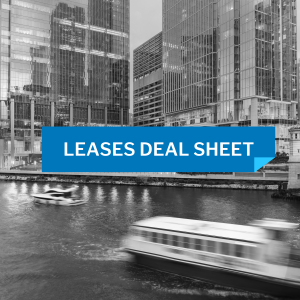The Port Authority: Chris Ward on the World Trade Center and Moynihan Station
By Jotham Sederstrom October 11, 2010 11:08 pm
reprints Since being appointed as executive director of the Port Authority of New York and New Jersey in 2008, Chris Ward has juggled an unruly tangle of infrastructural projects–some of them inherited from his predecessors and others all his own. Mr. Ward, 55, spoke candidly last week about a timetable for the construction of the World Trade Center, the dredging of the Panama Canal and the recently completed runway replacement at J.F.K.
Since being appointed as executive director of the Port Authority of New York and New Jersey in 2008, Chris Ward has juggled an unruly tangle of infrastructural projects–some of them inherited from his predecessors and others all his own. Mr. Ward, 55, spoke candidly last week about a timetable for the construction of the World Trade Center, the dredging of the Panama Canal and the recently completed runway replacement at J.F.K.
The Commercial Observer: Now that the Port Authority has a financial agreement in place with Larry Silverstein, can you gauge an accurate timetable for the construction of the Word Trade Center complex?
Mr. Ward: Now that we have a deal with Mr. Silverstein, all of the construction timetables that we set in our 2008 road map are now all achievable. The one complexity of that remains taking down 130 Liberty and the construction of the Vehicles Security Center, but our delivery dates for all the other infrastructure remains.
Larry Silverstein’s project–Tower 2–will be built at grade and then be available for when the market is there. As for Tower 3, we will finance his project when he secures an anchor tenant of size and financial commitment, and we should know that no later than by the end of 2012, because then he will be at the five- to six-story podium level. And if he hasn’t completed a tenant deal, he would stop at that point.
Obviously, when the tenants are out in the market we’re hopeful that Larry will secure the anchor tenant and the tower gets built. If it gets built with a tenant today he could be done in the middle of 2014. The final tower–Tower 4–we’re hopeful his work we’ll be done at the end of 2013.
Did Douglas Durst play a role in luring Condé Nast downtown, or did the Port Authority deal with the Durst Organization and Condé Nast independently?
Let me just say that the Durst negotiation was separate from Condé Nast and his proposal stood on the merits of how he approached One World Trade. He had what we would call a very thoughtful way to bring equity to the project and share risk with the Port Authority up and down. Our negotiations with Condé Nast were wholly separate from Douglas Durst.
Now, however, that we have the letter of intent with Condé Nast and a deal with Douglas Durst–obviously there’s some great knowledge and expertise and awareness about the company that Douglas Durst and his team have been very helpful on.
But during the selection process, those two did not cross.
There’s a lot of office construction slated for downtown Manhattan. Should all of those jobs come downtown as planned, will the transit infrastructure be in place, including the long-anticipated rail tunnel from New Jersey to New York?
I think the region is now seeing potentially the slowing down of the region’s port tunnel. Governor Christie is looking at the price tag on that, which I think he had some concerns with. So that project could have some real ramifications if it were to be significantly delayed or even stopped. But I think the transit access for the rest of the region–East Side access, Second Avenue and the Path upgrades–put us all in good shape.
[Editor’s note: On Oct. 7, after our interview with Mr. Ward, Governor Christie effectively canceled the port tunnel.]
How closely has the Port Authority been monitoring the dredging of the Panama Canal?
We’re obviously keenly aware of the delivery date of 2014. The president of Panama has reaffirmed 2014. We think of that as a very important innovation in the shipping world, that the two canals will then be able to accommodate the large vessels, and our long-term planning–not just the Bayonne Bridge but our long-term planning for the Port as a whole–will take into account how we can capture that Asian cargo that comes through the Pacific and then through the Panama up into the East Coast ports. We think it will have a significant regional benefit.
Are you worried about competition from, say, Charleston or Baltimore?
Yes. The port business is an extremely competitive business. We are not a state-run port like Norfolk, for example, which allows them to price their services below the market. So we’re very concerned about inefficient performance by competitive ports.
Give me an update on what’s happening with Stewart Airport?
Stewart has actually had a couple of interesting stories. It ranks very high in customer satisfaction. We’ve seen a long haul of European tours dedicated out of Stewart. All of that is to the good. We think Stewart will be a major player in the aviation world.
Nonetheless, we also recognize that the aviation industry is in a downward position right now. … But in the end, Stewart will be an important part of our five-year port system. We’re putting some projects in the air to handle TSA and Customs. Hopefully, more international travel will come in through Stewart.
The Bay Runway replacement was just completed at Kennedy International Airport. Looking back, how do you feel about the results?
It was probably the most complicated aviation project to close the largest runway in the United States and completely rebuild it in four months, and we did it ahead of time and on budget. If we had a situation that required airlines to redo all their schedules it would have been an enormous problem. It took two years to put those schedules together so we’re awfully proud of how we delivered that project. We just completed Phase II of that project, which wasn’t the runways but the hardstand and access roads to the runways, and we finished that on time and ahead of budget also. And I think it’s so important that projects like that are recognized.
You know, the public is so cynical about how we build and where we build, and the fact that we’re able to demonstrate that our $400 million project can be built on time and under budget is just a great accomplishment in restoring the public’s confidence.
What’s the latest with Moynihan Station? Will it ever get done?
We’ve made great progress on Phase I. We want to turn this into a transportation project to start, and not a real estate project. So we have negotiated with our joint venture partners and the federal government for the initiation of Phase I, which is about to kick off in probably late October. And with successful completion of Phase I, a demonstration of that project is going forward. We’ve had good communications with Washington on funding and partnership for Phase II.
But the mistakes with the early Moynihan Station was that it was overburdened with costs and complexity, and it was clear we had to break it down into manageable construction projects and build the transportation benefits over time and then realize the large-scale real estate development afterward.
I hear you’re a big music fan. What have you been listening to lately?
Actually, I’ve been listening to a lot of jazz. My favorite band is the Mekons, and Jon Langford is coming to town with his band Skull Orchard. I guess I’m a fan of a fair amount of rap. And I’m listening to the new Arcade Fire album.
It’s pretty good, right?
It’s good, but I like the first one better.
jsederstrom@observer.com


